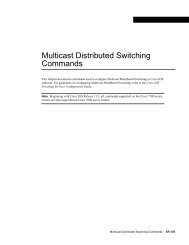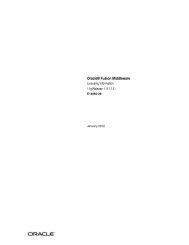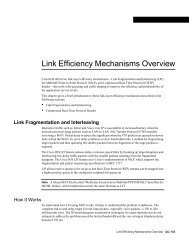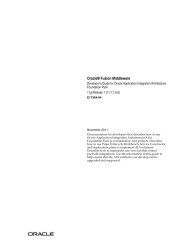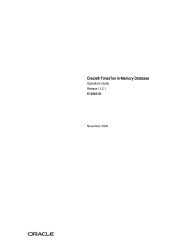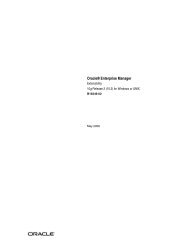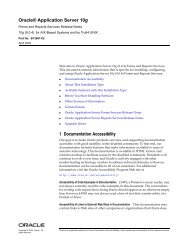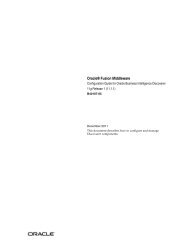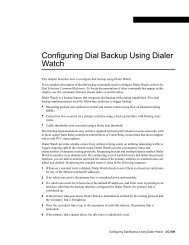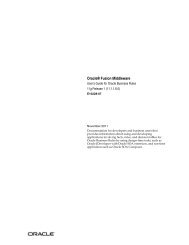Configuring 1- and 2-Port T1/E1 Multiflex Voice/WAN ... - docs.mind.ru
Configuring 1- and 2-Port T1/E1 Multiflex Voice/WAN ... - docs.mind.ru
Configuring 1- and 2-Port T1/E1 Multiflex Voice/WAN ... - docs.mind.ru
You also want an ePaper? Increase the reach of your titles
YUMPU automatically turns print PDFs into web optimized ePapers that Google loves.
Drop <strong>and</strong> Insert with VoIP <strong>and</strong> PSTN Services<br />
hostname RTR-A<br />
!<br />
voice-card 1<br />
codec complexity high<br />
!<br />
controller <strong>T1</strong> 1/0<br />
framing esf<br />
linecoding b8zs<br />
ds0-group 1 timeslots 1-12 type e&m-wink<br />
tdm-group 2 timeslots 13-24 type e&m<br />
!<br />
controller <strong>T1</strong> 1/1<br />
framing esf<br />
linecoding b8zs<br />
clock source line primary<br />
tdm-group 3 timeslots 13-24 type e&m<br />
!<br />
voice-port 1/0:1<br />
!<br />
dial-peer voice 1 voip<br />
destination-pattern 4...<br />
codec g723r63<br />
dtmf-relay h245-alpha<br />
session target ipv4:209.165.200.253<br />
session target ipv4:209.165.200.252<br />
!<br />
dial-peer voice 2 pots<br />
destination-pattern 5...<br />
prefix 5<br />
port 1/0:1<br />
!<br />
interface serial 0/0<br />
encapsulation ppp<br />
ip address 209.165.200.252 255.255.255.224<br />
!<br />
connect tdm1 <strong>T1</strong> 1/0 2 <strong>T1</strong> 1/1 3<br />
hostname RTR-B<br />
!<br />
voice-card 1<br />
codec complexity high<br />
!<br />
controller <strong>T1</strong> 1/0<br />
framing esf<br />
linecoding b8zs<br />
ds0-group 1 timeslots 1-12 type e&m-wink<br />
tdm-group 2 timeslots 13-24 type e&m<br />
!<br />
controller <strong>T1</strong> 1/1<br />
framing esf<br />
linecoding b8zs<br />
clock source line primary<br />
tdm-group 3 timeslots 13-24 type e&m<br />
!<br />
voice-port 1/0:1<br />
!<br />
dial-peer voice 1 voip<br />
destination-pattern 5….<br />
codec g723r63<br />
dtmf-relay h245-alpha<br />
!<br />
!<br />
!<br />
dial-peer voice 2 pots<br />
destination-pattern 4….<br />
prefix 4<br />
port 1/0:1<br />
!<br />
interface serial 0/0<br />
encapsulation ppp<br />
ip address 209.165.200.253 255.255.255.224<br />
!<br />
connect tdm1 <strong>T1</strong> 1/0 2 <strong>T1</strong> 1/1 3<br />
Clock Sources<br />
In this example, two clock sources are available on each router’s <strong>Multiflex</strong> VWIC ports: one from<br />
the PBX <strong>and</strong> one from the PSTN central office (CO). However, the clock sources must be the same,<br />
so the system adjusts to this need.<br />
The primary keyword of the clock source comm<strong>and</strong>, applied to <strong>T1</strong> 1/1, means that the PSTN is<br />
providing the clock source. The <strong>T1</strong> 1/0 port connected to the PBX is automatically put into<br />
looped-time mode, which means that the port takes the clocking received on its Rx (receive) pair <strong>and</strong><br />
regenerates it back on its Tx (transmit) pair. While it is receiving clocking, it does not drive the<br />
on-board clock. It is “spoofing” the port so that the connected PBX does not detect clocking that is<br />
out of synchronization, which is indicated by slips. The router detects the slips as controlled <strong>and</strong> does<br />
not force the port to fail.<br />
<strong>Configuring</strong> 1- <strong>and</strong> 2-<strong>Port</strong> <strong>T1</strong>/<strong>E1</strong> <strong>Multiflex</strong> <strong>Voice</strong>/<strong>WAN</strong> Interface Cards on Cisco 2600 <strong>and</strong> 3600 Series Routers 23



